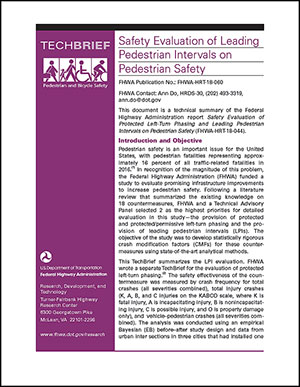U.S. Department of Transportation
Federal Highway Administration
1200 New Jersey Avenue, SE
Washington, DC 20590
202-366-4000
Federal Highway Administration Research and Technology
Coordinating, Developing, and Delivering Highway Transportation Innovations
| TECHBRIEF |
| This techbrief is an archived publication and may contain dated technical, contact, and link information |
| Publication Number: FHWA-HRT-18-060 Date: September 2018 |
Publication Number: FHWA-HRT-18-060 Date: September 2018 |
PDF Version (584 KB)
PDF files can be viewed with the Acrobat® Reader®
| FHWA Publication No.: FHWA-HRT-18-060 FHWA Contact: Ann Do, HRDS-30, (202) 493-3319, ann.do@dot.gov |
This document is a technical summary of the Federal Highway Administration report Safety Evaluation of Protected Left-Turn Phasing and Leading Pedestrian Intervals on Pedestrian Safety (FHWA-HRT-18-044).
Pedestrian safety is an important issue for the United States, with pedestrian fatalities representing approximately 16 percent of all traffic-related fatalities in 2016.(1) In recognition of the magnitude of this problem, the Federal Highway Administration (FHWA) funded a study to evaluate promising infrastructure improvements to increase pedestrian safety. Following a literature review that summarized the existing knowledge on 18 countermeasures, FHWA and a Technical Advisory Panel selected 2 as the highest priorities for detailed evaluation in this study—the provision of protected and protected/permissive left-turn phasing and the provision of leading pedestrian intervals (LPIs). The objective of the study was to develop statistically rigorous crash modification factors (CMFs) for these countermeasures using state-of-the-art analytical methods.
This TechBrief summarizes the LPI evaluation. FHWA wrote a separate TechBrief for the evaluation of protected left-turn phasing.(2) The safety effectiveness of the countermeasure was measured by crash frequency for total crashes (all severities combined), total injury crashes (K, A, B, and C injuries on the KABCO scale, where K is fatal injury, A is incapacitating injury, B is nonincapacitating injury, C is possible injury, and O is property damage only), and vehicle–pedestrian crashes (all severities combined). The analysis was conducted using an empirical Bayesian (EB) before–after study design and data from urban intersections in three cities that had installed one or both of the countermeasures of interest (Chicago, IL; New York City (NYC), NY; and Charlotte, NC).
At signalized intersections equipped with pedestrian-signal indications, it is common practice for the pedestrian “walk” interval to coincide with the adjacent circular green vehicle phase, creating a potential conflict between turning vehicles and pedestrians. LPI timing typically gives pedestrians the opportunity to enter an intersection 3 to 7 s before drivers are given a green signal. This “headstart” for pedestrians allows them to establish their presence in the crosswalk and places them in a location that is more visible to drivers. The use of an LPI is expected to result in the following benefits:
